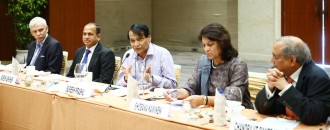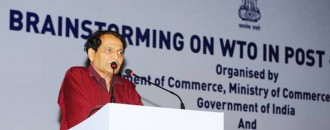
Spotting FDI-trade synergy can make a difference
However, traders should look at the changes closely to spot opportunities in future.
 Dr. K.S. Rao , General Manager (Strategic Planning), Bank of Baroda, Mumbai, India
Dr. K.S. Rao , General Manager (Strategic Planning), Bank of Baroda, Mumbai, IndiaAmong other measures to attract foreign funds, the government’s decision to increase the FDI cap from 26% to 49% in defence and insurance sectors is a far-reaching positive step. It can have a multiplier impact on boosting India’s economy. Moreover, the move to treat income from Foreign Investment Portfolio (FPI) as ‘capital gain’ instead of ‘business income’ provides clarification on treatment of its income that can put tax litigations to rest. Going forward, it is proposed to merge limits for foreign direct, portfolio investment, investment by NRIs and venture capital investors in most sectors into a composite cap that will enable free interchange of limits. It will provide a fillip to fund management activities; with current FPI estimated at $130 billion that can pick up more pace. It can also help in moving current ‘off shore’ fund management activities to India in due course when the clarified tax provisions come into force from April 1, 2015. Besides Private-Public-partnership (PPP), mustering global funds through Foreign Institutional Investors (FIIs) will be another strategic anchor to take the economy forward. FDI trends in the last decade Ever since the economic reforms have been initiated, the FDI inflows started bringing better scope for multidimensional growth across sectors. Gradual opening up of certain sectors for FDI has led to not only fund flows but also technology and know-how which are critical for the economic prosperity and trade. The total cumulative inflow of FDI from April 2000 to April 2014 works out to around $326.5 billion and $219.3 billion from equity/NRIs. These figures are likely to increase in with better policies in future. Importantly, the rising confidence in the Indian economy has begun to make a difference. During April - May 2014, the foreign inflows grew 34% to $5.30 billion compared to $3.95 billion received in the same period last year. As far as country-wise ownership of FDI is concerned, Mauritius ranks at the top with 36% inflows, next is Singapore with 12% and UK with around 10%. Sectoral FDI distribution shows that service sector has 18% share, followed by construction, telecommunication and computer hardware. With the hike in FDI caps, the inflows are set to rise further. The rationale for liberalizing FDI The accelerated FDI regime has not only benefited India but also many other countries. The world is getting more and more interconnected with international trade picking up greater volumes. According to the World Trade Organization (WTO), global trade has grown from 15.7 trillion in 2008 to over $18.8 trillion in 2013. As a result, global incomes have risen and many countries have climbed the ladder of development lifting hundreds of millions of people out of poverty. Trade, underpinned by the multilateral trading system, has been a powerful force for growth and development. Much Foreign Direct Investment (FDI) today is related to trade flows that link imports and exports in production along supply chains. Investment is also an important transmission mechanism for spreading technology, knowledge and innovation. In a globalizing economy, financial resources – domestic or foreign – can be a great differentiator. While deregulation and opening of markets have led the way, continuous improvements in supporting infrastructure and the quality of institutions will be crucial for sustaining private capital inflows. Some developing countries have become capital exporters in recent years, with outflows of FDI increasing from close to zero in the early 1990s to more than $400 billion in 2010. Foreign capital flows also facilitate the development of international supply chains. FDI increases export possibilities for intermediate products and services, such as design and research and development (R&D) as well. The transfer of technology and knowledge associated with FDI is likely to influence the country’s comparative advantage over time. India’s FDI policies changing for the better India’s FDI policy vis-à-vis other major emerging market economies (EMEs) reveals that though India’s approach towards foreign investment has been relatively conservative to begin with, it progressively started catching-up with the more liberalized policy stance of other EMEs. From the early 1990s, things have progressed in terms of wider access to different sectors of the economy, ease of starting business, repatriation of dividend and profits, and relaxations regarding norms for owning equity. This progressive liberalization, coupled with considerable improvement in terms of macroeconomic fundamentals, reflected in growing size of FDI flows to the country that increased nearly five-fold during 2000-2010. Competition for FDI In a competing global environment, where countries are in the lookout for overseas funds and to the extent that investment and trade are complementary, the quest for sourcing such overseas funds will continue. In future, global investment rules could ensure a more efficient allocation of resources across borders, which in turn would help trade. Bilateral or regional agreements, which are being increasingly used to govern international investment, run the risk of creating regulatory divergence, which needs to be appropriately addressed. Moreover, the overseas development assistance and migrant remittances have played a part in financing the savings-investment gap in low-income countries. The WTO’s Aid for Trade initiative is also important in this regard as it can increase a country’s supply capacity. The importance of FDI in increasing capital formation in low-income countries in the future should not be underestimated. In order to attract foreign capital inflows, low-income countries will need to adopt stable macroeconomic policies and develop strong institutions, such as a sound legal framework, effective transparency arrangements and independent regulation. Impact of FDI Increase in FDI facilitates cross border trade, inbound/outbound exchange of financial resources, banking services, skill sets, mobility of men and technology and many more interchanges among nations. In the process, the synergy of unique differentiator or the capabilities of one country are well harnessed by another country which aligns their diplomatic relations. The new globalizing spirit has been guiding increased international cooperation, global prosperity and economic growth. Like many nations, India too recognized the merits of globalization and began opening many sectors for FDI. By continuing the reform process, the current budgetary provisions have rightly set a new tone for accelerating foreign inflows. The buoyancy arising out of surge in external inflows will call for more focused exchange rate management taking into account its impact on the inflation, export performance, current account deficit and other interdependent macroeconomic dimensions. But on the whole, when a 360-degree view is taken, such a broad approach can help India catapult its growth and achieve a double-digit growth in the next five to seven years. It is up to traders and entrepreneurs to spot the right growth opportunities and harness the potentiality of such inflows.
Dr. K.S. Rao is the General Manager (Strategic Planning), Bank of Baroda, Mumbai, India





 to success.
to success.